Electricity Generation in LCA of Electric Vehicles: A Review
Abstract
:1. Introduction
2. Method
2.1. Articles Selection
2.2. Review Approach
- Methodological characteristics: Goal, intended audience and applications (both explicit or inferred), and modelling choice (attributional versus consequential, whenever the study cohere to this distinction);
- Descriptive characteristics of the assessed electricity mix: Regional boundaries, time horizon, calculation methods, technology involved (average versus marginal suppliers), and data source.
3. Literature Results
3.1. Goal and Scope
- Lee et al. [10] evaluating medium duty trucks.
- Vehicle based LCA;
- Fleet based scenarios.
3.2. System Modelling and Inventory Choices
3.2.1. Consequential System Modelling
CLCA in Electric Mobility
Marginal Mixes Selection
“…small changes in the composition of the vehicle stock, replacing an ICE with an EV will represent an increase on the margin of electricity generation…”[22]
“Marginal grid GHG intensity gives a more realistic measure of the GHG impact of the growth of electric vehicles than does average grid GHG intensity.”
“…assessing a technology that entails a change in electricity consumption require MEF…”[28]
“It better represents the effects of the of EV adoption in the near future…”[22]
“It is useful for short term forecasts of electricity demand…”[25]
Time Horizon
Short Term Marginal Mix—Calculation Method
- Temporal resolution or granularity (aggregate versus temporally explicit);
- Time frame (retrospective versus prospective);
- Spatial boundary.
Top down approach
Bottom up approach
- They are suitable to model future power plant scenarios and large load changes [42];
- They have limited scalability [42];
- They could require large number of inputs and their complexity represents a significant hurdle for incorporation in LCA [85];
- The results depend heavily on the input data and on assumptions made by the user [85].
Considerations
3.2.2. Attributional System Modelling
- Data quality: Transparent and up-to-date electricity data are not the norm. Especially when relying on background databases, studies tend to overlook the data quality of the selected dataset.
- Regional boundary: The region of production of electricity and that of consumption do not always coincide. Selecting the adequate regional boundary is a trade-off between representativeness and the problem of modelling cross boundary flows.
- Time: Generally temporal granularity in attributional LCA is one year. However also for average electricity mixes, there can be significant differences from one year to another. To overcome this obstacle, some studies average the emissions over a longer time span.
- Future scenarios’ definition and stylised states adoption. (A ‘stylised state’ is denoted an extreme state (e.g. a state where all electricity and heat is produced from coal) that is unlikely to materialise but that could illustrate important technology differences in a clear way [87]).
Data Quality
Geographical Boundary
Production and Supply
Temporal Boundary
3.3. Data Quality
3.3.1. LCA Databases
3.3.2. Grid Databases
3.3.3. Literature Sources
3.3.4. Forecasts
3.4. Results
3.4.1. Quantitative Results
Influence of Electricity Mixes in the Results
Factors Influencing the Mix
3.4.2. Recommendations for Policy Makers in the Literature
- 7 studies stating that EVs are not decreasing GHG (6 using marginal mixes);
- 4 studies being cautious on the adoption of EVs (all using marginal mixes);
- 13 studies presenting EVs as an efficient decarbonising technology (5 using marginal mixes).
4. Conclusions and Recommendations
Supplementary Materials
Author Contributions
Funding
Acknowledgments
Conflicts of Interest
References
- Hawkins, T.R.; Gausen, O.M.; Strømman, A.H. Environmental impacts of hybrid and electric vehicles-a review. Int. J. Life Cycle Assess. 2012, 17, 997–1014. [Google Scholar] [CrossRef]
- Nordelöf, A.; Messagie, M.; Tillman, A.; Söderman, M.L.; Van Mierlo, J. Environmental impacts of hybrid, plug-in hybrid, and battery electric vehicles—What can we learn from life cycle assessment? Int. J. Life Cycle Assess. 2014, 19, 1866–1890. [Google Scholar] [CrossRef]
- Graff Zivin, J.; Kotchen, M.; Mansur, E. Spatial and temporal heterogeneity of marginal emissions: Implications for electric cars and other electricity-shifting policies. J. Econ. Behav. Organ. 2014, 107, 248–268. [Google Scholar] [CrossRef]
- Elgowainy, A.; Burnham, A.; Wang, M.; Molburg, J.; Rousseau, A. Well-To-Wheels Energy Use and Greenhouse Gas Emissions of Plug-in Hybrid Electric Vehicles. SAE Int. J. Fuels Lubr. 2009, 2, 627–644. [Google Scholar] [CrossRef]
- Gaines, L.; Sullivan, J.; Burnham, A.; Belharouak, I. Life-cycle analysis of production and recycling of lithium ion batteries. Transp. Res. Rec. 2011, 2252, 57–65. [Google Scholar] [CrossRef]
- Notter, D.; Gauch, M.; Widmer, R.; Wäger, P.; Stamp, A.; Zah, R.; Althaus, H. Contribution of Li-Ion Batteries to the Environmental Impact of Electric Vehicles. Environ. Sci. Technol. 2010, 44, 6550–6556. [Google Scholar] [CrossRef] [PubMed]
- Majeau-Bettez, G.; Hawkins, T.R.; Strømman, A.H. Life cycle environmental assessment of lithium-ion and nickel metal hydride batteries for plug-in hybrid and battery electric vehicles. Environ. Sci. Technol. 2011, 45, 4548–4554. [Google Scholar] [CrossRef] [PubMed]
- Hawkins, T.; Singh, B.; Majeau Bettez, G.; Stromman, A.; Strømman, A. Comparative Environmental Life Cycle Assessment of Conventional and Electric Vehicles. J. Ind. Ecol. 2013, 17, 53–64. [Google Scholar] [CrossRef]
- Girardi, P.; Gargiulo, A.; Brambilla, P. A comparative LCA of an electric vehicle and an internal combustion engine vehicle using the appropriate power mix: The Italian case study. Int. J. Life Cycle Assess. 2015, 20, 1127–1142. [Google Scholar] [CrossRef]
- Lee, D.; Thomas, V. Parametric modeling approach for economic and environmental life cycle assessment of medium-duty truck electrification. J. Clean. Prod. 2017, 142, 3300–3321. [Google Scholar] [CrossRef]
- Noori, M.; Gardner, S.; Tatari, O. Electric vehicle cost, emissions, and water footprint in the United States: Development of a regional optimization model. Energy 2015, 89, 610–625. [Google Scholar] [CrossRef]
- Garcia, J.; Millet, D.; Tonnelier, P.; Richet, S.; Chenouard, R. A novel approach for global environmental performance evaluation of electric batteries for hybrid vehicles. J. Clean. Prod. 2017, 156, 406–417. [Google Scholar] [CrossRef] [Green Version]
- Huo, H.; Cai, H.; Zhang, Q.; Liu, F.; He, K. Life-cycle assessment of greenhouse gas and air emissions of electric vehicles: A comparison between China and the U.S. Atmos. Environ. 2015, 108, 107–116. [Google Scholar] [CrossRef]
- Bartolozzi, I.; Rizzi, F.; Frey, M. Comparison between hydrogen and electric vehicles by life cycle assessment: A case study in Tuscany, Italy. Appl. Energy 2013, 101, 103–111. [Google Scholar] [CrossRef]
- Giordano, A.; Fischbeck, P.; Matthews, H.S. Environmental and economic comparison of diesel and battery electric delivery vans to inform city logistics fleet replacement strategies. Transp. Res. Part D 2017. [Google Scholar] [CrossRef]
- Helmers, E.; Dietz, J.; Hartard, S. Electric car life cycle assessment based on real-world mileage and the electric conversion scenario. Int. J. Life Cycle Assess. 2017, 22, 15–30. [Google Scholar] [CrossRef]
- Helmers, E.; Marx, P. Electric cars: Technical characteristics and environmental impacts. Environ. Sci. Eur. 2012, 24, 14. [Google Scholar] [CrossRef]
- Lombardi, L.; Tribioli, L.; Cozzolino, R.; Bella, G. Comparative environmental assessment of conventional, electric, hybrid, and fuel cell powertrains based on LCA. Int. J. Life Cycle Assess. 2017, 22, 1989–2006. [Google Scholar] [CrossRef]
- European Commission, Joint Research Centre, Institute for Environment and Sustainability (Ed.) ILCD Handbook-General Guide for Life Cycle Assessment-Detailed Guidance; Publications Office of the European Union: Luxembourg, 2010; 417p. [Google Scholar] [CrossRef]
- Bohnes, F.; Gregg, J.; Laurent, A. Environmental Impacts of Future Urban Deployment of Electric Vehicles: Assessment Framework and Case Study of Copenhagen for 2016–2030. Environ. Sci. Technol. 2017, 51, 13995–14005. [Google Scholar] [CrossRef] [PubMed]
- Garcia, R.; Gregory, J.; Freire, F. Dynamic fleet-based life-cycle greenhouse gas assessment of the introduction of electric vehicles in the Portuguese light-duty fleet. Int. J. Life Cycle Assess. 2015, 20, 1287–1299. [Google Scholar] [CrossRef] [Green Version]
- Archsmith, J.; Kendall, A.; Rapson, D. From Cradle to Junkyard: Assessing the Life Cycle Greenhouse Gas Benefits of Electric Vehicles. Res. Transp. Econ. 2015, 52, 72–90. [Google Scholar] [CrossRef] [Green Version]
- Bauer, C.; Hofer, J.; Althaus, H.; Del Duce, A.; Simons, A. The environmental performance of current and future passenger vehicles: Life cycle assessment based on a novel scenario analysis framework. Appl. Energy 2015, 157, 871–883. [Google Scholar] [CrossRef]
- Kannan, R.; Turton, H. Cost of ad-hoc nuclear policy uncertainties in the evolution of the Swiss electricity system. Energy Policy 2012, 50, 391–406. [Google Scholar] [CrossRef]
- Crossin, E.; Doherty, P.J.B. The effect of charging time on the comparative environmental performance of different vehicle types. Appl. Energy 2016, 179, 716–726. [Google Scholar] [CrossRef]
- Faria, R.; Marques, P.; Moura, P.; Freire, F.; Delgado, J.; de Almeida, A. Impact of the electricity mix and use profile in the life-cycle assessment of electric vehicles. Renew. Sust. Energy Rev. 2013, 24, 271–287. [Google Scholar] [CrossRef]
- Freire, F.; Marques, P. Electric vehicles in Portugal: An integrated energy, greenhouse gas and cost life-cycle analysis. In Proceedings of the 2012 IEEE International Symposium on Sustainable Systems and Technology (ISSST), Boston, MA, USA, 16–18 May 2012; IEEE: Piscataway, NJ, USA, 2012. [Google Scholar]
- Garcia, R.; Freire, F. Marginal Life-Cycle Greenhouse Gas Emissions of Electricity Generation in Portugal and Implications for Electric Vehicles. Resources 2016, 5, 41. [Google Scholar] [CrossRef]
- Lanati, F.; Benini, M.; Gelmini, A. Impact of the penetration of electric vehicles on the Italian power system: A 2030 scenario. In Proceedings of the 2011 IEEE Power and Energy Society General Meeting, Detroit, MI, USA, 24–28 July 2011; p. 3403. [Google Scholar]
- Nitsch, J.; Pregger, T.; Naegler, T.; Heide, D.; Luca de Tena, D.; Trieb, F.; Scholz, Y.; Nienhaus, K.; Gerhardt, N.; Sterner, M. Langfristszenarien und Strategien für den Ausbau der erneuerbaren Energien in Deutschland bei Berücksichtigung der Entwicklung in Europa und global. 2012. Available online: https://www.researchgate.net/publication/259895385 (accessed on 14 August 2018).
- Lucas, A.; Alexandra Silva, C.; Costa Neto, R. Life cycle analysis of energy supply infrastructure for conventional and electric vehicles. Energy Policy 2012, 41, 537–547. [Google Scholar] [CrossRef]
- Ma, H.; Balthasar, F.; Tait, N.; Riera Palou, X.; Harrison, A. A new comparison between the life cycle greenhouse gas emissions of battery electric vehicles and internal combustion vehicles. Energy Policy 2012, 44, 160–173. [Google Scholar] [CrossRef]
- McCarthy, R.; Yang, C. Determining marginal electricity for near-term plug-in and fuel cell vehicle demands in California: Impacts on vehicle greenhouse gas emissions. J. Power Sources 2010, 195, 2099–2109. [Google Scholar] [CrossRef]
- Marshall, B.M.; Kelly, J.C.; Lee, T.; Keoleian, G.A.; Filipi, Z. Environmental assessment of plug-in hybrid electric vehicles using naturalistic drive cycles and vehicle travel patterns: A Michigan case study. Energy Policy 2013, 358–370. [Google Scholar] [CrossRef]
- Noshadravan, A.; Cheah, L.; Roth, R.; Freire, F.; Dias, L.; Gregory, J. Stochastic comparative assessment of life-cycle greenhouse gas emissions from conventional and electric vehicles. Int. J. Life Cycle Assess. 2015, 20, 854–864. [Google Scholar] [CrossRef] [Green Version]
- Messagie, M.; Coosemans, T.; Van Mierlo, J. The influence of electricity allocation rules in environmental assessments of electric vehicles. In Proceedings of the 28th International Electric Vehicle Symposium and Exhibition, Goyang, Korea, 3–6 May 2015; Korean Society of Automotive Engineers: Seoul, Korea, 2015; p. 1252. [Google Scholar]
- Onat, N.; Kucukvar, M.; Tatari, O. Conventional, hybrid, plug-in hybrid or electric vehicles? State-based comparative carbon and energy footprint analysis in the United States. Appl. Energy 2015, 150, 36–49. [Google Scholar] [CrossRef]
- Hadley, S.; Tsvetkova, A. Potential Impacts of Plug-in Hybrid Electric Vehicles on Regional Power Generation. Electr. J. 2009, 22, 56–68. [Google Scholar] [CrossRef] [Green Version]
- Stephan, C.; Sullivan, J. Environmental and Energy Implications of Plug-In Hybrid-Electric Vehicles. Environ. Sci. Technol. 2008, 42, 1185–1190. [Google Scholar] [CrossRef] [PubMed]
- Van Mierlo, J.; Messagie, M.; Rangaraju, S. Comparative environmental assessment of alternative fueled vehicles using a life cycle assessment. Transp. Res. Procedia 2017, 25, 3435–3445. [Google Scholar] [CrossRef]
- Messagie, M.; Boureima, F.; Coosemans, T.; Macharis, C.; Mierlo, J. A Range-Based Vehicle Life Cycle Assessment Incorporating Variability in the Environmental Assessment of Different Vehicle Technologies and Fuels. Energies 2014, 7, 1467–1482. [Google Scholar] [CrossRef] [Green Version]
- Weis, A.; Jaramillo, P.; Michalek, J. Consequential life cycle air emissions externalities for plug-in electric vehicles in the PJM interconnection. Environ. Res. Lett. 2016, 11, 024009. [Google Scholar] [CrossRef] [Green Version]
- Yuksel, T.; Tamayao, M.; Hendrickson, C.; Azevedo, I.M.L.; Michalek, J. Effect of regional grid mix, driving patterns and climate on the comparative carbon footprint of gasoline and plug-in electric vehicles in the United States. Environ. Res. Lett. 2016, 11, 044007. [Google Scholar] [CrossRef] [Green Version]
- Siler Evans, K.; Azevedo, I.; Morgan, M.G. Marginal Emissions Factors for the U.S. Electricity System. Environ. Sci. Technol. 2012, 46, 4742–4748. [Google Scholar] [CrossRef] [PubMed]
- Tagliaferri, C.; Evangelisti, S.; Acconcia, F.; Domenech, T.; Ekins, P.; Barletta, D.; Lettieri, P. Life cycle assessment of future electric and hybrid vehicles: A cradle-to-grave systems engineering approach. Chem. Eng. Res. Des. 2016, 112, 298–309. [Google Scholar] [CrossRef] [Green Version]
- Tamayao, M.; Michalek, J.; Hendrickson, C.; Azevedo, I.M.L. Regional Variability and Uncertainty of Electric Vehicle Life Cycle CO2 Emissions across the United States. Environ. Sci. Technol. 2015, 49, 8844–8855. [Google Scholar] [CrossRef] [PubMed]
- Thomas, C.E. US marginal electricity grid mixes and EV greenhouse gas emissions. Int. J. Hydrogen Energy 2012, 37, 19231–19240. [Google Scholar] [CrossRef]
- Dallinger, D.; Wietschel, M.; Santini, D.J. Effect of demand response on the marginal electricity used by plug-in electric vehicles. World Electr. Veh. J. 2012, 4, 2766–2774. [Google Scholar] [CrossRef]
- Van Vliet, O.; Brouwer, A.; Kuramochi, T.; van den Broek, M.; Faaij, A. Energy use, cost and CO2 emissions of electric cars. J. Power Sources 2011, 196, 2298–2310. [Google Scholar] [CrossRef]
- Van den Broek, M.; Veenendaal, P.; Koutstaal, P.; Turkenburg, W.; Faaij, A. Impact of international climate policies on CO2 capture and storage deployment. Energy Policy 2011, 39, 2000–2019. [Google Scholar] [CrossRef]
- Faria, R.; Moura, P.; Delgado, J.; de Almeida, A.T. A sustainability assessment of electric vehicles as a personal mobility system. Energy Convers. Manag. 2012, 61, 19–30. [Google Scholar] [CrossRef]
- Woo, J.; Choi, H.; Ahn, J. Well-to-wheel analysis of greenhouse gas emissions for electric vehicles based on electricity generation mix: A global perspective. Transp. Res. Part D 2017, 51, 340–350. [Google Scholar] [CrossRef]
- Gao, L.; Winfield, Z.C. Life cycle assessment of environmental and economic impacts of advanced vehicles. Energies 2012, 5, 605–620. [Google Scholar] [CrossRef]
- Ambrose, H.; Kendall, A. Effects of battery chemistry and performance on the life cycle greenhouse gas intensity of electric mobility. Transp. Res. Part D 2016, 47, 182–194. [Google Scholar] [CrossRef] [Green Version]
- Deng, Y.; Li, J.; Li, T.; Gao, X.; Yuan, C. Life cycle assessment of lithium sulfur battery for electric vehicles. J. Power Sources 2017, 343, 284–295. [Google Scholar] [CrossRef]
- Zackrisson, M.; Avellán, L.; Orlenius, J. Life cycle assessment of lithium-ion batteries for plug-in hybrid electric vehicles—Critical issues. J. Clean. Prod. 2010, 18, 1519–1529. [Google Scholar] [CrossRef]
- Oliveira, L.; Messagie, M.; Rangaraju, S.; Sanfelix, J.; Hernandez Rivas, M.; Van Mierlo, J. Key issues of lithium-ion batteries—From resource depletion to environmental performance indicators. J. Clean. Prod. 2015, 108, 354–362. [Google Scholar] [CrossRef]
- Sanfélix, J.; Messagie, M.; Omar, N.; Van Mierlo, J.; Hennige, V. Environmental performance of advanced hybrid energy storage systems for electric vehicle applications. Appl. Energy 2015, 137, 925–930. [Google Scholar] [CrossRef]
- Roux, C.; Schalbart, P.; Peuportier, B. Development of an electricity system model allowing dynamic and marginal approaches in LCA—tested in the French context of space heating in buildings. Int. J. Life Cycle Assess. 2017, 22, 1177–1190. [Google Scholar] [CrossRef]
- Alvarez Gaitan, J.; Short, M.; Peters, G.; MacGill, I.; Moore, S. Consequential cradle-to-gate carbon footprint of water treatment chemicals using simple and complex marginal technologies for electricity supply. Int. J. Life Cycle Assess. 2014, 19, 1974–1984. [Google Scholar] [CrossRef]
- Colett, J.; Kelly, J.; Keoleian, G. Using Nested Average Electricity Allocation Protocols to Characterize Electrical Grids in Life Cycle Assessment. J. Ind. Ecol. 2016, 20, 29–41. [Google Scholar] [CrossRef]
- Curran, M.; Mann, M.; Norris, G. The international workshop on electricity data for life cycle inventories. J. Clean. Prod. 2005, 13, 853–862. [Google Scholar] [CrossRef]
- Earles, J.M.; Halog, A. Consequential life cycle assessment: A review. Int. J. Life Cycle Assess. 2011, 16, 445–453. [Google Scholar] [CrossRef]
- Why and When? Available online: www.consequential-lca.org (accessed on 6 February 2018).
- Sandén, B.; Karlström, M. Positive and negative feedback in consequential life-cycle assessment. J. Clean. Prod. 2007, 15, 1469–1481. [Google Scholar] [CrossRef]
- Hernandez, M.; Messagie, M.; De Gennaro, M.; Van Mierlo, J. Resource depletion in an electric vehicle powertrain using different LCA impact methods. Resour. Conserv. Recycl. 2016. [Google Scholar] [CrossRef]
- Gemechu, E.; Sonnemann, G.; Young, S. Geopolitical-related supply risk assessment as a complement to environmental impact assessment: The case of electric vehicles. Int. J. Life Cycle Assess. 2017, 22, 31–39. [Google Scholar] [CrossRef]
- Frischknecht, R.; Benetto, E.; Dandres, T.; Heijungs, R.; Roux, C.; Schrijvers, D.; Wernet, G.; Yang, Y.; Messmer, A.; Tschuemperlin, L. LCA and decision making: When and how to use consequential LCA; 62nd LCA Forum, Swiss Federal Institute of Technology, Zürich, 9 September 2016. Int. J. Life Cycle Assess. 2017, 22, 296–301. [Google Scholar] [CrossRef]
- Onat, N.; Noori, M.; Kucukvar, M.; Zhao, Y.; Tatari, O.; Chester, M. Exploring the suitability of electric vehicles in the United States. Energy 2017, 121, 631–642. [Google Scholar] [CrossRef]
- McCarthy, R.W. Impacts of electric-drive vehicles on California’s energy system. In Proceedings of the 23rd International Battery, Hybrid and Fuel Cell Electric Vehicle Symposium and Exposition 2007—Sustainability: The Future of Transportation, EVS 2007, Anaheim, CA, USA, 2–5 December 2007; Volume 3, pp. 1771–1789. [Google Scholar]
- Weidema, B.P. Attributional or consequential Life Cycle Assessment: A matter of social responsibility. J. Clean. Prod. 2018, 174, 305–314. [Google Scholar] [CrossRef]
- Ministry of Climate and Energy (Ed.) Energy Strategy 2050—from Coal, Oil and Gas to Green Energy; Danish Government: Copenhagen, Denmark, 2011; 66p. Available online: http://www.danishwaterforum.dk/activities/Climate%20change/Dansk_Energistrategi_2050_febr.2011.pdf (accessed on 14 August 2018).
- International Energy Agency. Energy Policies of IEA countries—Denmark 2011 Review; IEA Publications: Paris, France, 2011; p. 158. [Google Scholar]
- Zamagni, A.; Guinée, J.; Heijungs, R.; Masoni, P.; Raggi, A. Lights and shadows in consequential LCA. Int. J. Life Cycle Assess. 2012, 17, 904–918. [Google Scholar] [CrossRef]
- Ekvall, T.; Weidema, B.P. System boundaries and input data in consequential life cycle inventory analysis. Int. J. Life Cycle Assess. 2004, 9, 161–171. [Google Scholar] [CrossRef]
- Example. Marginal Electricity in Denmark. Available online: www.consequential-lca.org (accessed on 30 January 2018).
- Further Theory on the Special Case of Electricity—Forecasting and Time Horizon. Available online: www.consequential-lca.org (accessed on 30 January 2018).
- Soimakallio, S.; Kiviluoma, J.; Saikku, L. The complexity and challenges of determining GHG (greenhouse gas) emissions from grid electricity consumption and conservation in LCA (life cycle assessment)—A methodological review. Energy 2011, 36, 6705–6713. [Google Scholar] [CrossRef]
- Weidema, B.P.; Ekvall, T.; Heijungs, R. Guidelines for application of deepened and broadened LCA. Technical report for CALCAS Project. 2009. Available online: https://lca-net.com/publications/show/guidelines-applications-deepened-broadened-lca/ (accessed on 14 August 2018).
- Lund, H.; Mathiesen, B.; Christensen, P.; Schmidt, J. Energy system analysis of marginal electricity supply in consequential LCA. Int. J. Life Cycle Assess. 2010, 15, 260–271. [Google Scholar] [CrossRef]
- Schmidt, J.H.; Thrane, M.; Merciai, S.; Dalgaard, R. Inventory of Country Specific Electricity in LCA-Consequential and Attributional Scenarios. Methodology Report v2. 2011. Available online: https://lca-net.com/publications/show/inventory-country-specific-electricity-lca-consequential-attributional-scenarios-methodology-report-v2/ (accessed on 14 August 2018).
- Weidema, B.P. Market Information in Life Cycle Assessment. 2003. Available online: http://citeseerx.ist.psu.edu/viewdoc/download?doi=10.1.1.197.5739&rep=rep1&type=pdf (accessed on 14 August 2018).
- Mathiesen, B.; Münster, M.; Fruergaard, T. Uncertainties related to the identification of the marginal energy technology in consequential life cycle assessments. J. Clean. Prod. 2009, 17, 1331–1338. [Google Scholar] [CrossRef]
- Yang, C. A framework for allocating greenhouse gas emissions from electricity generation to plug-in electric vehicle charging. Energy Policy 2013, 60, 722–732. [Google Scholar] [CrossRef]
- Ryan, N.; Johnson, J.; Keoleian, G. Comparative Assessment of Models and Methods to Calculate Grid Electricity Emissions. Environ. Sci. Technol. 2016, 50, 8937–8953. [Google Scholar] [CrossRef] [PubMed]
- Plevin, R.; Delucchi, M.; Creutzig, F. Using Attributional Life Cycle Assessment to Estimate Climate-Change Mitigation Benefits Misleads Policy Makers. J. Ind. Ecol. 2014, 18, 73–83. [Google Scholar] [CrossRef]
- Hillman, K.M.; Sanden, B.A. Time and scale in Life Cycle Assessment: The case of fuel choice in the transport sector. Int. J. Altern. Propul. 2008, 2, 1–12. [Google Scholar] [CrossRef]
- Marriott, J.; Matthews, H.S. Environmental Effects of Interstate Power Trading on Electricity Consumption Mixes. Environ. Sci. Technol. 2005, 39, 8584–8590. [Google Scholar] [CrossRef] [PubMed] [Green Version]
- Itten, R.; Frischknecht, R.; Stucki, M. Life Cycle Inventories of Electricity Mixes and Grid; Treeze Ltd.: Uster, Switzerland, 2014. [Google Scholar] [CrossRef]
- Climate Change Knowledge Portal. Available online: http://sdwebx.worldbank.org/climateportal/index.cfm?page=country_historical_climate&ThisCCode=PRT (accessed on 1 March 2018).
- GaBi Databases. Available online: http://www.gabi-software.com/italy/databases/gabi-databases/ (accessed on 21 March 2018).
- Argonne National Laboratory Greet 2016 Manual. 2016. Available online: https://greet.es.anl.gov/publication-greet-manual (accessed on 14 August 2018).
- Lenzen, M. Life cycle energy and greenhouse gas emissions of nuclear energy: A review. Energy Convers. Manag. 2008, 49, 2178–2199. [Google Scholar] [CrossRef]
- Sovacool, B. Valuing the greenhouse gas emissions from nuclear power: A critical survey. Energy Policy 2008, 36, 2950–2963. [Google Scholar] [CrossRef]
- Fthenakis, V.; Kim, H.; Alsema, E. Emissions from Photovoltaic Life Cycles. Environ. Sci. Technol. 2008, 42, 2168–2174. [Google Scholar] [CrossRef] [PubMed] [Green Version]
- Pehnt, M. Dynamic life cycle assessment (LCA) of renewable energy technologies. Renew. Energy 2006, 31, 55–71. [Google Scholar] [CrossRef]
- U.S. Energy Information Administration. Annual Energy Outlook 2013—With Projections to 2040; U.S. Energy Information Administration: Washington, DC, USA, 2013; p. 233.
- IEA. Energy Policies of IEA Countries: European Union 2014 Review; IEA Publications: Paris, France, 2014; p. 312. [Google Scholar]
- NEEDS. Available online: http://www.needs-project.org/needswebdb/search.php (accessed on 16 February 2018).
- Frischknecht, R.; Flury, K. Life cycle assessment of electric mobility: Answers and challenges—Zurich, April 6, 2011. Int. J. Life Cycle Assess. 2011, 16, 691–695. [Google Scholar] [CrossRef]
- Doucette, R.; McCulloch, M. Modeling the CO2 emissions from battery electric vehicles given the power generation mixes of different countries. Energy Policy 2011, 39, 803–811. [Google Scholar] [CrossRef]
- Treyer, K. Datasets Related to Electricity Production and Supply in Ecoinvent Version 3—Short Overview. 2015. Available online: http://www.proyectaryproducir.com.ar/public_html/Seminarios_Posgrado/Material_de_referencia/ecoinvent-electricity%20datasets%20201305%20final.pdf (accessed on 14 August 2018).
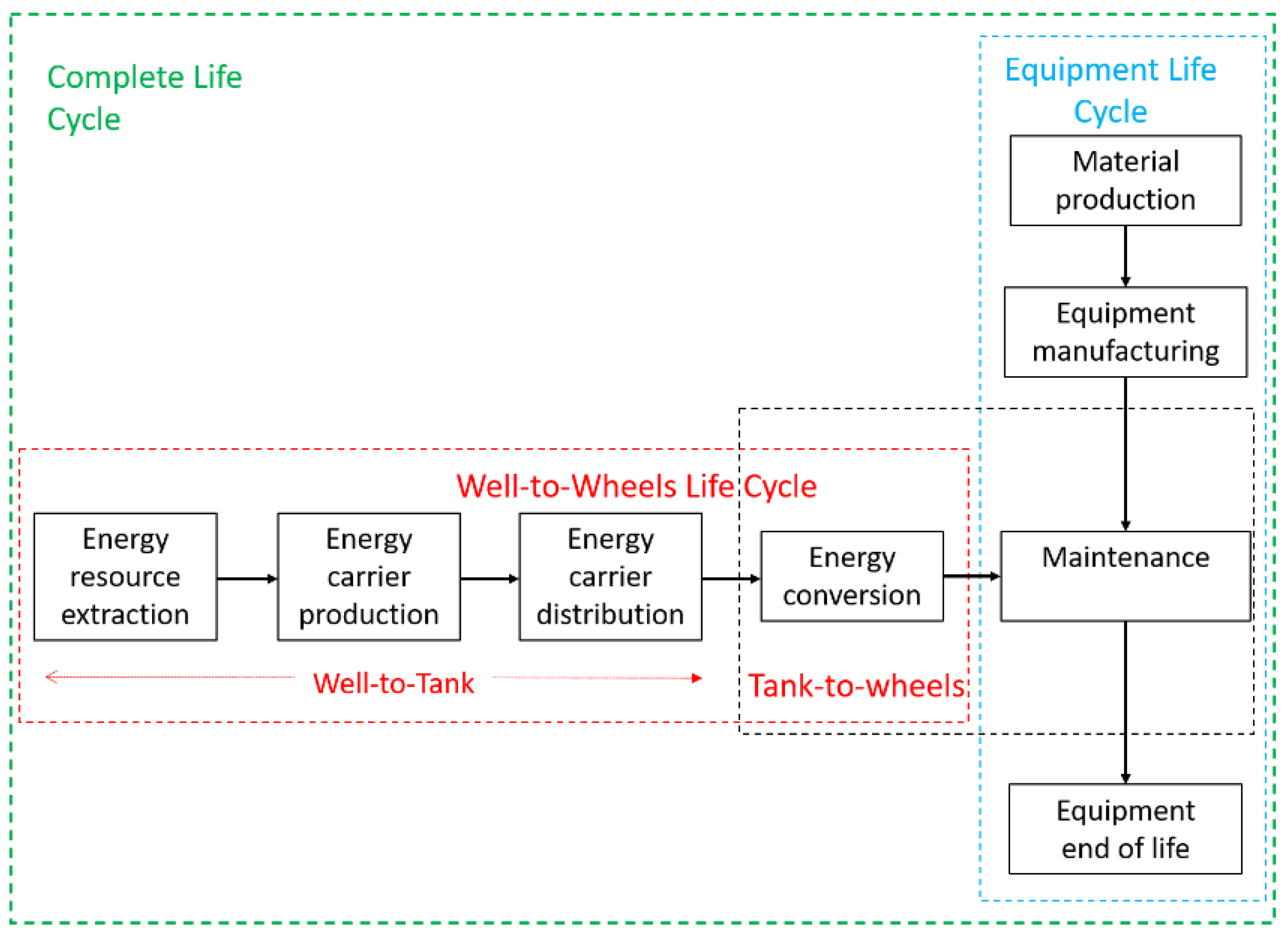

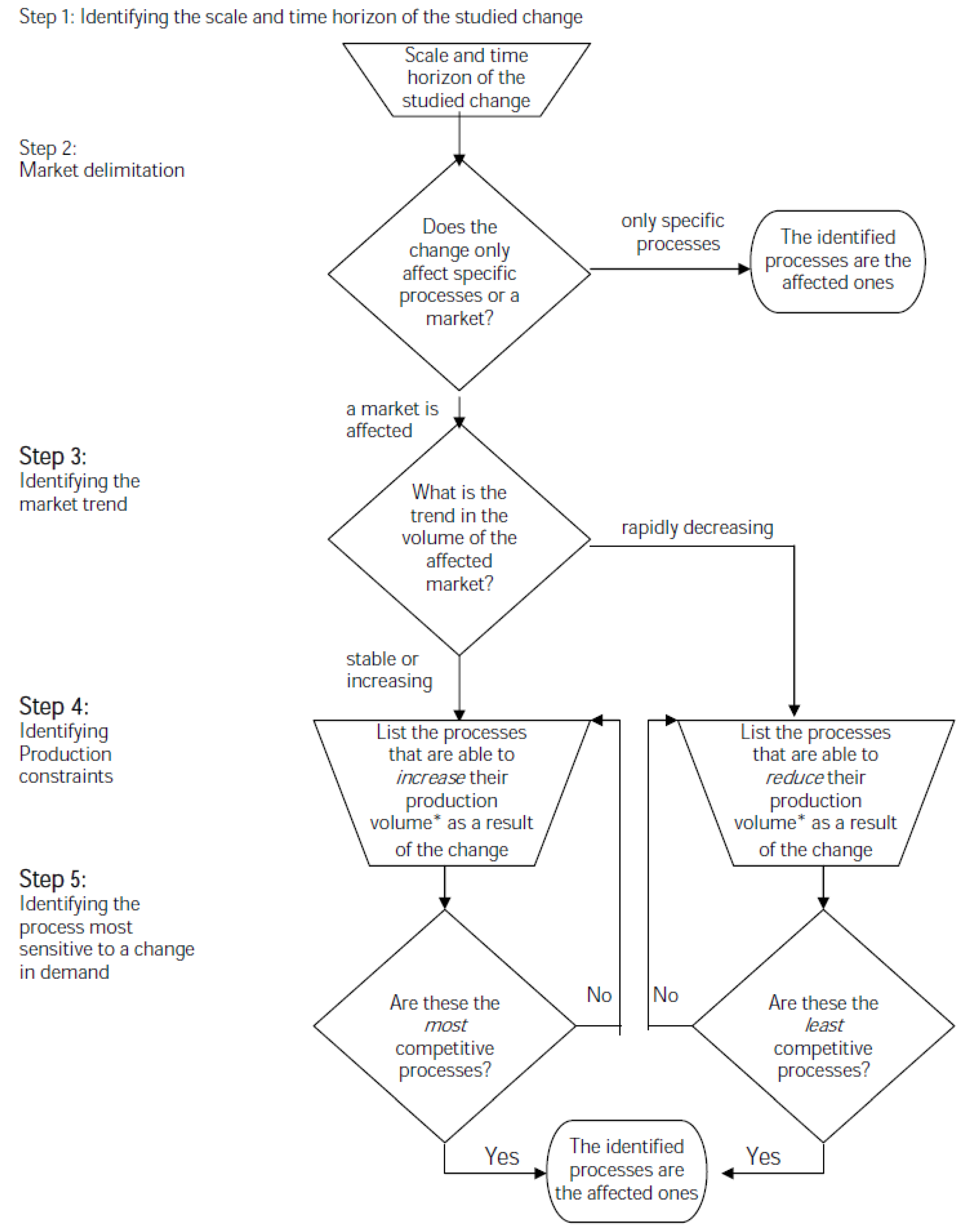
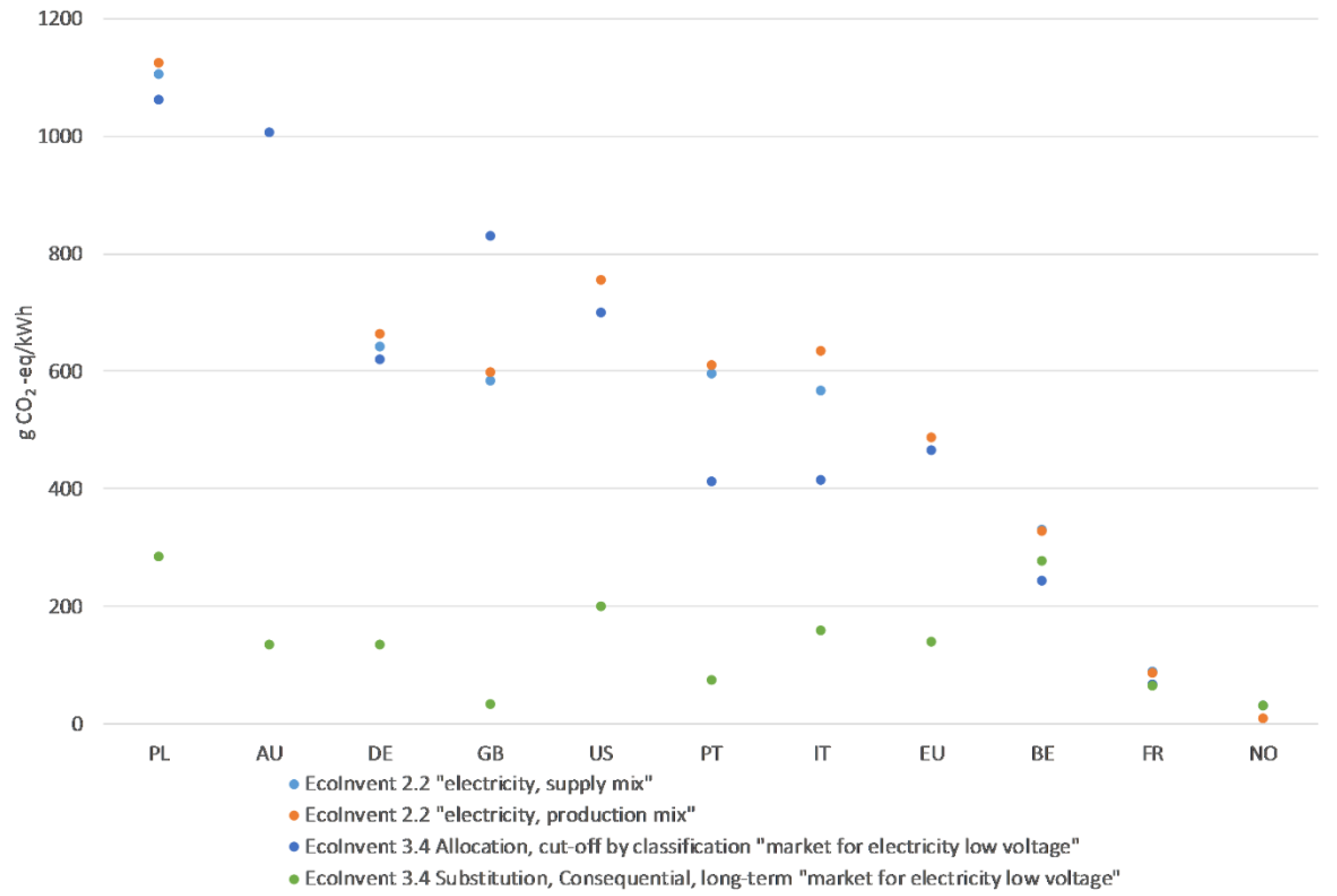
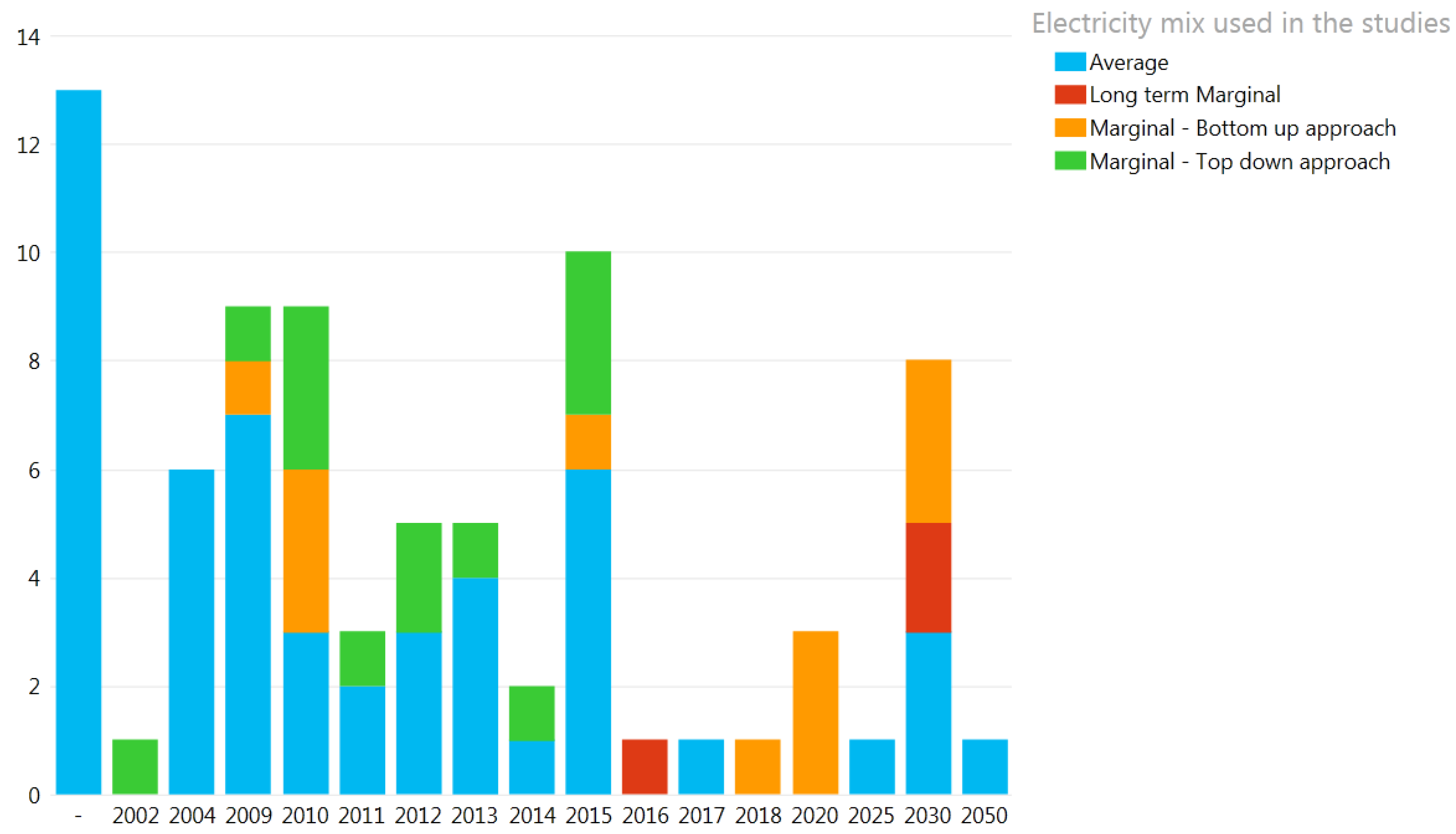
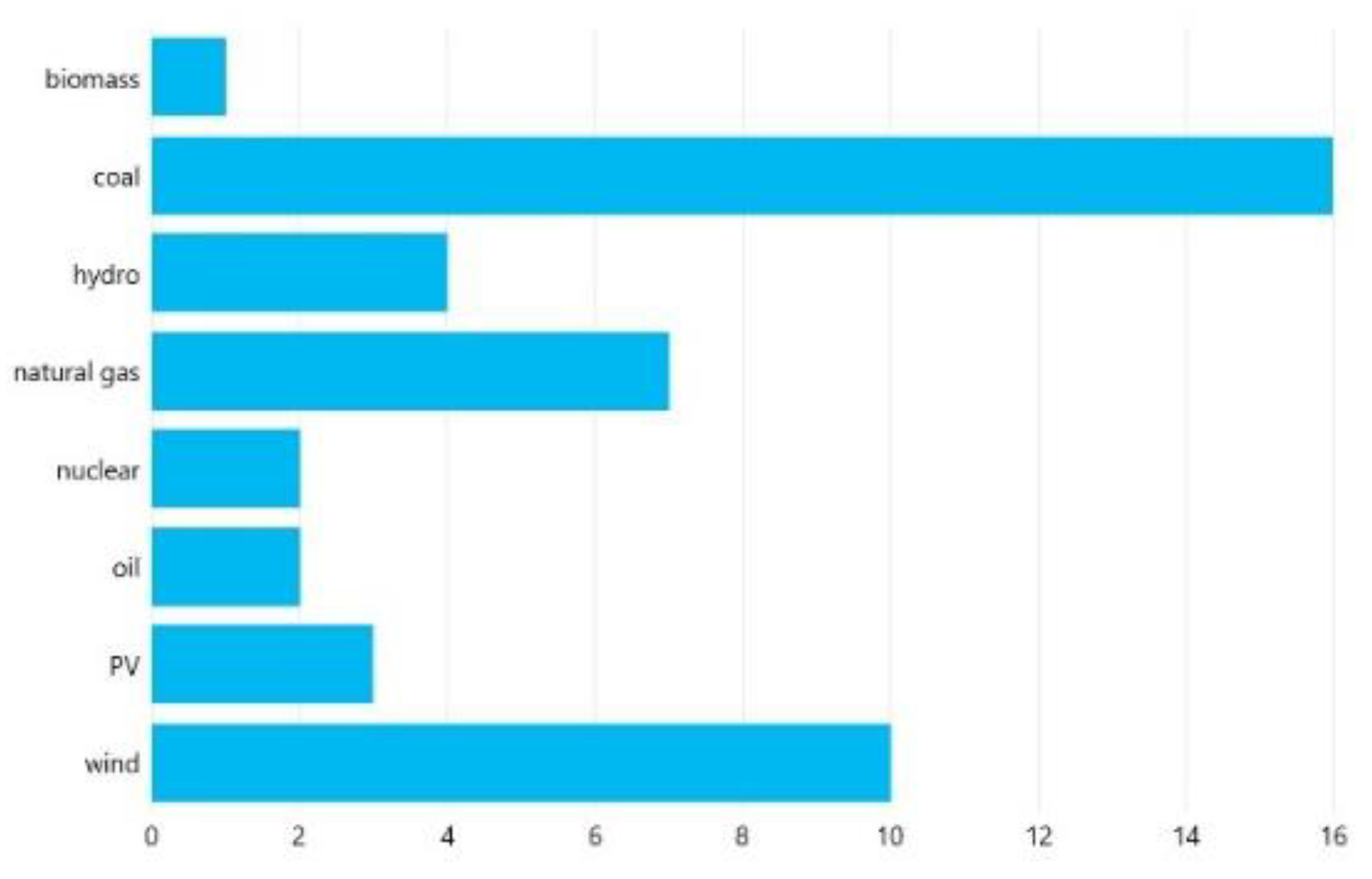

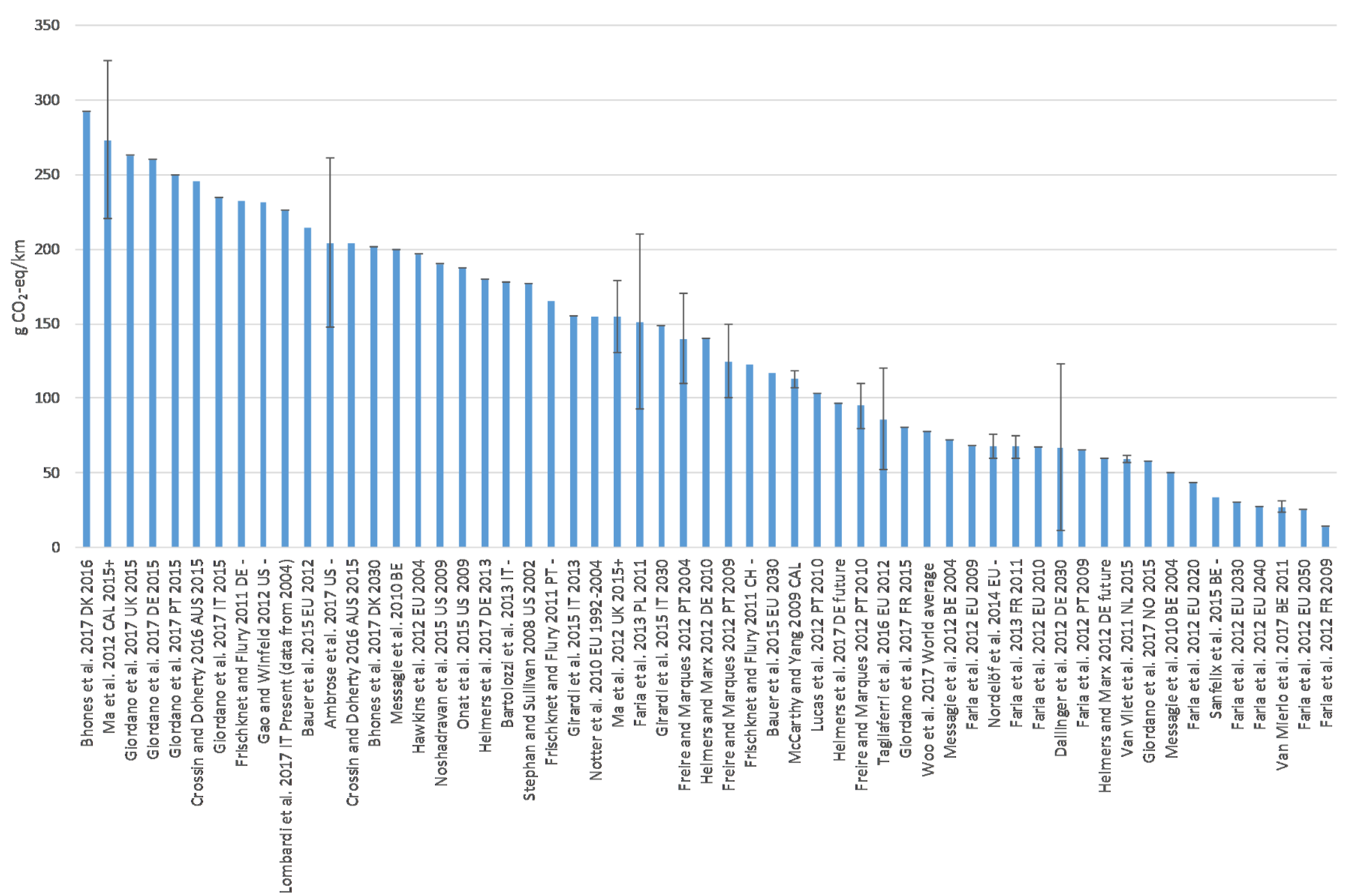
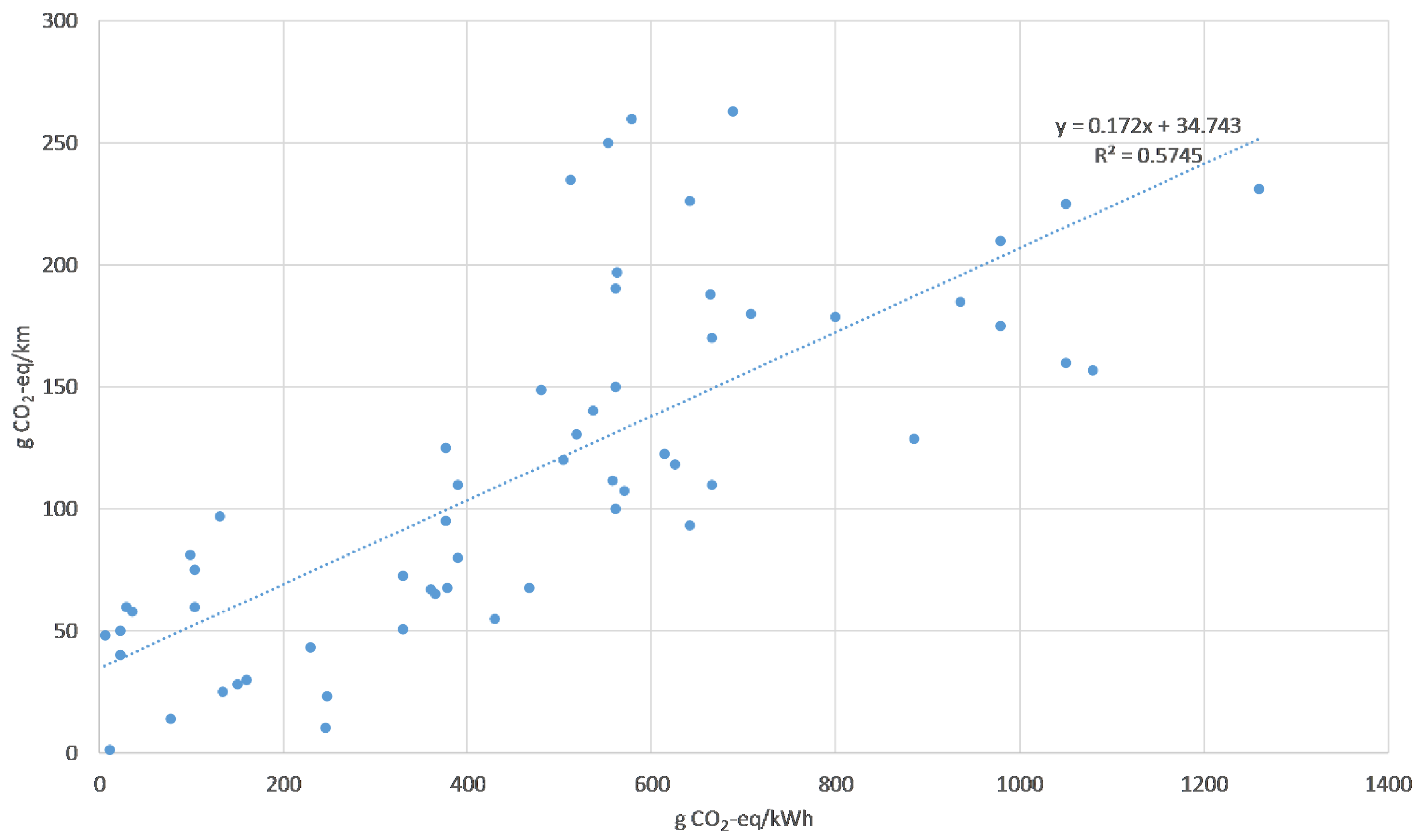
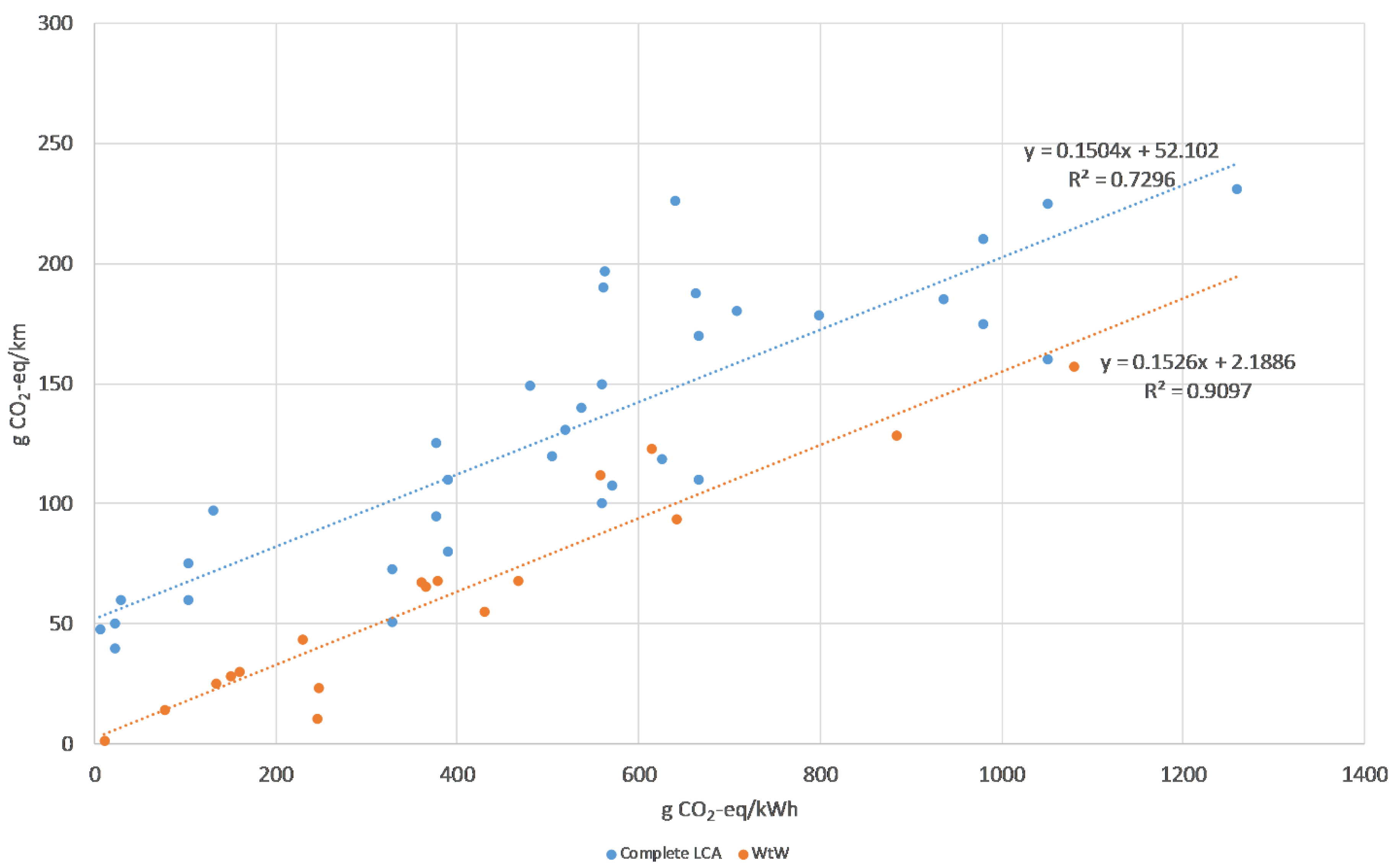
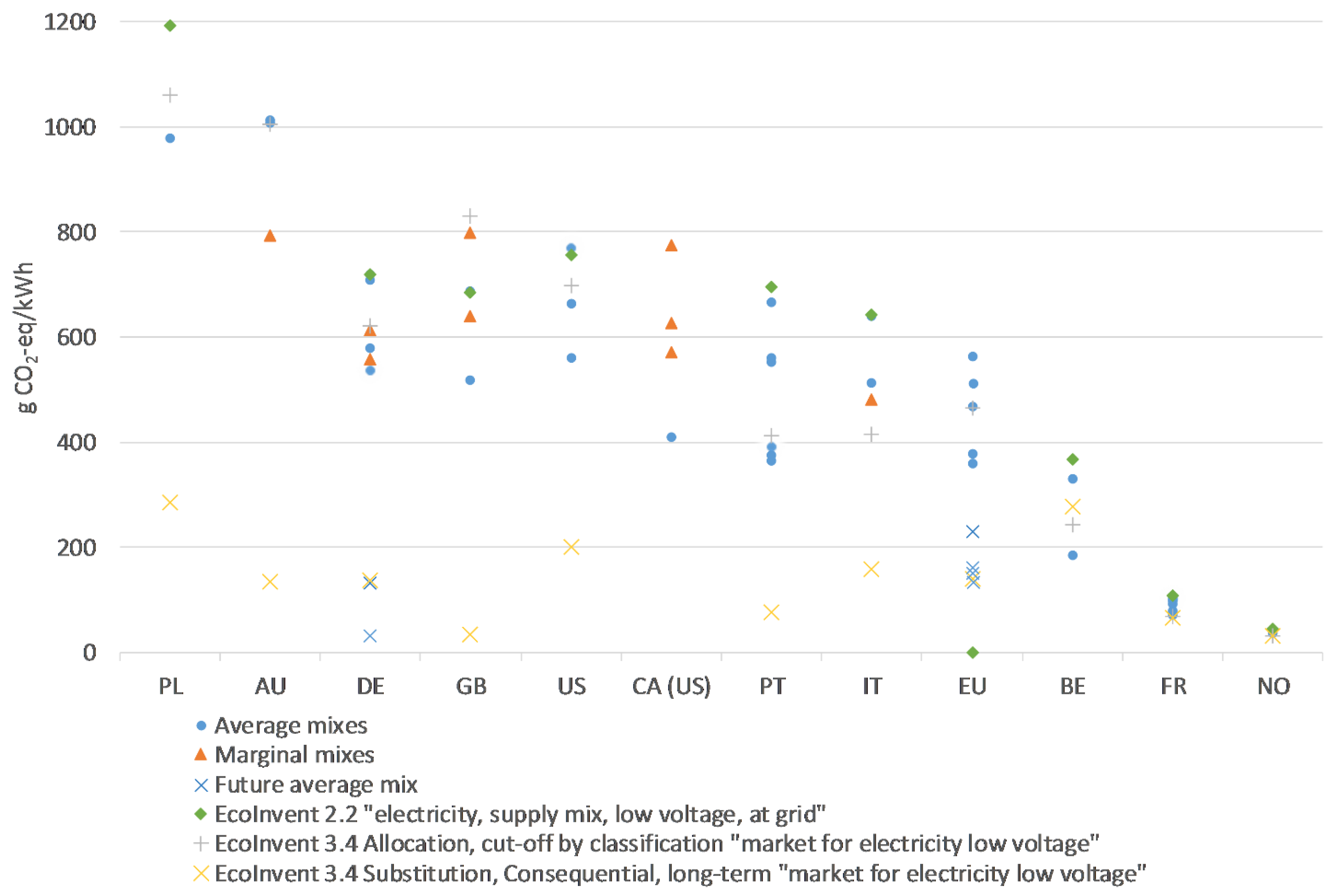
| Authors | Region | Time Horizon | Penetration Rate | Vehicle | Electricity mix | BEV Impact (GHG) | |||
|---|---|---|---|---|---|---|---|---|---|
| Average | Marginal | Source | GHG Intensity | ||||||
| Complete LCA | |||||||||
| Archsmith et al., 2017 [22] | US NERC regions | 2011–2012 | - | ICEV, EV | a | EPA’s Continuous Emissions Monitoring Systems (CEMS); GREETnet | 513–1258 g CO2-eq/kWh | 4.22–6.11 ton CO2eq/vehicle/year (rebound effect included) (average 5.22) | |
| 2030 2040 | x | EIA forecasts | - | - | |||||
| Bartolozzi et al., 2013 [14] | Italy | - | - | BEV, ICHE, FC LCV (Piaggio Porter) | x | - | EcoInvent (unspecified version) | - | 178.25 g CO2-eq/km |
| Bauer et al., 2015 [23] | Switzerland (EU 27 mix in use phase) | 2012 | - | ICEV, HEV, Plug-in Hybrid (PHEV), BEV, FCV, FCHEV | x | EcoInvent v. 2.2 | - | 214 g CO2-eq/km EU electricity mix (BEV mid size, average efficiency 0.77 mj/km) | |
| 2030 | x | Kannan and Turton [24] and ESU-services/IFEU 2008 | - | 117 g CO2-eq/km EU mix (BEV mid size, average efficiency 0.64 mj/km) | |||||
| Bohnes et al., 2013 [20] | Denmark | From 2016 to 2030 | - | ICV, BEV, HEV, PHEV, nPHEV, REEV, FCEV fleet analysis | d | EcoInvent 3.1 Substitution, consequential updated with EU and DK projections | - | From 292 g CO2-eq/km in 2016 to 202 g CO2-eq/km in 2030 | |
| Crossin and Doherty 2016 [25] | Australia | 2015 | - | PHEV, ICEV | x | Australian Energy market operator | 1006 g CO2-eq/kWh | 246 g CO2-eq/km | |
| a | 794 g CO2-eq/kWh | 204 g CO2-eq/km | |||||||
| Faria et al., 2013 [26] | Poland | 2011 | - | gasoline and diesel ICEVs, PHEVs, BEVs, FCEVs | x | European Environment Aagency (EEA) 2011 | 979 g CO2-eq/kWh | 210 g CO2-eq/km (compact)” 175 g CO2-eq/km (subcompact peugeot iOn)” | |
| Portugal | 376 g CO2-eq/kWh | 125 g CO2-eq/km (compact)” 95 g CO2-eq/km (subcompact peugeot iOn)” | |||||||
| France | 103 g CO2-eq/kWh | 75 g CO2-eq/km (compact)” 60 g CO2-eq/km (subcompact peugeot iOn)” | |||||||
| Freire and Marques 2012 [27] | Portugal | 2004 | - | BEV, PHEV, gasoline, Diesel (compact and subcompact passenger vehicles) | x | REN | 666 g CO2-eq/kWh | 170 g CO2-eq/km (compact) 110 g CO2-eq/km (subcompact) | |
| 2009 | 560 g CO2-eq/kWh | 150 g CO2-eq/km (compact) 100 g CO2-eq/km (subcompact) | |||||||
| 2010 | 390 g CO2-eq/kWh | 110 g CO2-eq/km (compact) 80 g CO2-eq/km (subcompact) | |||||||
| Garcia and Freire 2016 [28] | Portugal | 2015–2017 | 35–59 GWh in 2017 | BEV | x | REN | 352 g CO2-eq/kWh | 352 g CO2-eq/km | |
| a | 723 g CO2-eq/km | ||||||||
| Girardi et al., 2015 [9] | Italy | 2013 (data from 2012) | “few EVs” | EV, ICEV | a | TRENA | 155 g CO2-eq/km (vehicle efficiency 0.19 kWh/km) | ||
| 2030 | +17.5 TWh | c(b) | Lanati et al. [29] | 480 g CO2-eq/kWh | 148.88 g CO2-eq/km (vehicle efficiency 0.19 kWh/km) | ||||
| Hawkins et al., 2012 [1] | EU | - | - | EV Li-NCM, EV LifePO4, ICEV diesel, ICEV gasoline | x | EcoInvent v. 2.2 | 562 g CO2-eq/kWh EU mix* | 196.79 g CO2-eq/km (0.713 kWh/km) | |
| Helmers et al., 2017 [16] | Germany | Present (data 2004) | - | BEV, ICEV, FCV new ICEV Smart, new e-Smart, Smart converted from combustion engine to electric; BEV, ICEV, FCV | x | EcoInvent v. 2.2 | 719.5 g CO2-eq/kWh | - | |
| 2013 | IEA | 707.4 g CO2-eq/kWh | 180 g CO2-eq/km | ||||||
| Generic future based on renewables | Nitsch et al., 2012 [30] | 130.6 g CO2-eq/kWh | 97 g CO2-eq/km | ||||||
| Helmers and Marx 2012 [17] | Germany | 2010 | - | BEV, ICEV, FCV smart: ICEV, e-SMART; BEV, ICEV, FCV | x | German federal environmental agency | 536 g CO2-eq/kWh | 140 g CO2-eq/km | |
| Lee et al., 2017 [10] | US states | 2014 | - | medium duty TRUCK diesel, biodiesel, biodiesel hybrid, CNG, CNG hybrid, electric) | x | EPA’s CEM hourly data and NEI database | - | - | |
| a | - | - | |||||||
| Lucas et al., 2012 [31] | Portugal | 2010 | - | gasoline, diesel, FCHEV, FCPHEV, EV | x | REN | - | 61 g CO2-eq/km | |
| Ma et al., 2012 [32] | UK | 2015+ (data from 2009–2010) | - | ICEV, HEV, BEV Mid size in UK | x | BM report | 518.4 g CO2-eq/kWh | 130.6 g CO2-eq/km | |
| a | 799.2 g CO2-eq/kWh | 178.7 g CO2-eq/km | |||||||
| California | 2015+ (data from 2010) | SUV in California; | x | McCarthy and Yang 2009 [33] | - | 220.4 g CO2-eq/km | |||
| c(b) | - | 326.6 g CO2-eq/km | |||||||
| McCarthy and Yang 2009 [33] | California | 2010 | 1% of VMT | ICEV, HEV, PHEV, BEV, FCV | x | eGRID v.1.1 (2007) | 250 g CO2-eq/kWh | ||
| b | 626 g CO2-eq/kWh (off peak marginal) 571 g CO2-eq/kWh (load level marginal) | 118.32 g CO2-eq/km (WTW) 107.44 g CO2-eq/km (WTW) | |||||||
| Marshall et al., 2013 [34] | Michigan | 2009 | 10% infiltration, additional 2.41 × 1010 MJ | mid size PHEV | b | - | - | 547–611 g CO2-eq/km (PHEV, efficiency 0.45 kWh/km) | |
| Noshadravan et al., 2015 [35] | US | 2009 | - | EV, ICEV | 227.1–894.2 g CO2-eq/kWh 560.65 g CO2-eq/kWh | 190 g CO2-eq/km” | |||
| Messagie et al., 2015 [36] | Belgium | 2012 2013 2017 | - | x | ELIA (Belgian DSO) | - | - | ||
| Onat et al., 2015 [37] | US states | 2009 | - | mid size BEV, ICEV, PHEV, HEV | x | eGrid | 663.4 g CO2-eq/kWh | 187.72 g CO2-eq/km | |
| 2020 | c (b) | Hadley and Tsvetkova [38] | range 644–911 g CO2-eq/kWh | ||||||
| Stephan and Sullivan 2008 [39] | US regions | 2002 | “a significant number” | PHEV | x | EPA | 608.4 g CO2-eq/kWh’ | 177 g CO2/km (PHEV, efficiency 0.92 MJ/km) (WTW) | |
| 2002 | a | ||||||||
| 2030 | d | 157 g CO2-eq/km | |||||||
| Van Mierlo et al., 2017 [40] | Belgium | 2011 | - | BEV, Compressed Natural Gas (CNG), Liquid Petrol Gas (LPG), Biogas (BG), PHEV, HEV | x | Messagie et al., 2014 [41] | 190 g CO2-eq/kWh | 31–24 g CO2-eq/km (wtw) | |
| Weis et al., 2016 [42] | US PJM | 2010 2018 | - | EV, HEV and conventional gasoline | b | UCED model (data from NEEDS database and EPA projections) | - | - | |
| Yuksel et al., 2016 [43] | US states | 2011 | - | 2013 Nissan Leaf BEV; 2013 Chevrolet Volt PHEV; 2013 Toyota Prius PHEV; Toyota Prius HEV; the Mazda 3 | c (a) | Siler-Evans et al. [44] | 430–932 kg CO2-eq/MWh | - | |
| Giordano et al., 2017 [15] | UK | 2015 | - | light duty vehicle (IVECO daily) BEV, diesel | x | EcoInvent 3.0 updated with data for 2015 from Entso-e | 688 g CO2-eq/kWh | 263 g CO2-eq/km, ni-nacl2 battery 2015 bev | |
| Germany | 579 g CO2-eq/kWh | 260 g CO2-eq/km, ni-nacl2 battery 2015 bev | |||||||
| Portugal | 553 g CO2-eq/kWh | 250 g CO2-eq/km, ni-nacl2 battery 2015 bev | |||||||
| Italy | 512 g CO2-eq/kWh | 235 g CO2-eq/km, ni-nacl2 battery 2015 bev | |||||||
| France | 98 g CO2-eq/kWh | 81 g CO2-eq/km, ni-nacl2 battery 2015 bev | |||||||
| Norway | 36. g CO2-eq/kWh | 58 g CO2-eq/km, ni-nacl2 battery 2015 bev | |||||||
| Lombardi et al., 2017 [18] | Italy | Present (data 2004) | - | gasoline ICEV, EV, gasoline PHEV, PHFCV | x | EcoInvent v. 2.2 | 640.8 g CO2-eq/kWh | 226 g CO2-eq/km | |
| USA | 770.4 g CO2-eq/kWh | - | |||||||
| France | 93.6 g CO2-eq/kWh | - | |||||||
| Tagliaferri et al., 2016 [45] | EU | 2012 | - | BEV (Nissan Leaf), ICEV (Toyota Yaris); PHEV | x | EcoInvent v. 2.2 | - | 120 g CO2-eq/km (Nissan leaf EVI 0.50 MJ/km)111 g CO2-eq/km (Nissan leaf EVII 0.50 MJ/km) | |
| 2050 | Behrens et al., 2013 (2050) | - | - | ||||||
| Tamayao et al., 2015 [46] | US regions | 2009 | - | PHEV (Chevrolet Volt), HEV (Toyota Prius), BEV (Nissan Leaf) | x | ANL | - | - | |
| a | Siler-Evans et al., 2012 [44] Graff Zivin et al., 2014 [3] | - | - | ||||||
| W-t-W Analysis | |||||||||
| Thomas 2012 [47] | US electrical power regions | 2020 | - | HEV, PHEV, BEV | c (b) | Hadley and Tsvetkova [38] | - | - | |
| Dallinger et al., 2012 [48] | Germany | 2030 | 12 milion EV | BEV | b | own calculation Elgowainy et al., 2010 [4] | 247.26 construction and dispatch of RES to serve EVs 245.42 construction and dispatch of RES to serve EVs614 long term high RES mix (2030) 558.21 long term high RES mix (2030) | 23.4 g CO2-eq/km last trip charging; 10.7 g CO2-eq/km DSM charging; 122.84 g CO2-eq/km DSM charging; least marginal cost dispatch 111.64 g CO2-eq/km last trip charging; least marginal cost dispatch | |
| Van Vliet et al., 2011 [49] | Nederland | 2015 | - | SHEV, BEV, PHEV, gasoline, diesel | b | Van den Broek et al. [50] | - | 62 g CO2-eq/km (uncoordinated charging) 57 g CO2-eq/km (off-peak charging) | |
| Faria et al., 2012 [51] | Portugal | 2009 | - | ICE, HEV, PHEV, BEV, future BEV | x | - | Eea Eurostat | 365 g CO2-eq/kWh | 65.3 g CO2-eq/km’ |
| France | 78 g CO2-eq/kWh | 14 g CO2-eq/km’ | |||||||
| EU | 2009 | 378 g CO2-eq/kWh | 68 g CO2-eq/km’ | ||||||
| 2010 | 360 g CO2-eq/kWh | 67.3 g CO2-eq/km’ | |||||||
| 2020 | 230 g CO2-eq/kWh | 43.3 g CO2-eq/km’ | |||||||
| 2030 | 160 g CO2-eq/kWh | 30 g CO2-eq/km’ | |||||||
| 2040 | 150 g CO2-eq/kWh | 28 g CO2-eq/km’ | |||||||
| 2050 | 135 g CO2-eq/kWh | 25.3 g CO2-eq/km’ | |||||||
| Woo et al. 2017 [52] | 70 countries | 2014 | - | EV, ICEV | x | - | IEA (2015b), EIA (2015) World Bank (2016) | - | 78.1 g CO2-eq/km (world average) |
| Huo et al., 2015 [13] | US (3 regions), China (3 regions) | 2012 | EV, PHEV, ICEV | x | - | 190–290 g CO2-eq/km’ “(China), 110–225 (US) g CO2-eq/km’ “ | |||
| 2025 | EIA (2015) | - | 110–160 g CO2-eq/km’ “ (China), 60–150 (US) g CO2-eq/km’ “ | ||||||
| Gao and Winfeld 2012 [53] | US | CV (Toyota Corolla), HEV(Prius), PHEV (Prius Plug-in), EREV (GM Volt), EV (Nissan Leaf), FCV (Honda Clarity) | x | GREET | - | 240 g CO2-eq/km“ (efficiency 0.213 kWh/km) | |||
| Battery LCA | |||||||||
| Ambrose et al., 2016 [54] | US states | see Archsmith | - | c(a) | Archsmith et al. [22] | - | - | ||
| Majeau-Bettez et al., 2011 [7] | EU | - | x | EcoInvent v. 2.2 | - | - | |||
| Deng et al., 2017 [55] | US | - | x | Thinkstep (unspecified version) | - | - | |||
| Zackrisson et al., 2010 [56] | West Europe, Scandinavia, China | - | x | - | - | ||||
| Garcia et al., 2017 [12] | EU-27 France | - | x | - | - | ||||
| Oliveira et al., 2015 [57] | Belgium (EU mix) | 2011 (data from 2004) | - | x | 516 g CO2-eq/kWh | - | |||
| Sanfelix et al., 2015 [58] | EU | - | x | 33.9 g CO2-eq/km (WtW 25.7 g CO2-eq/km) | |||||
| Notter et al., 2010 [6] | EU | - | BEV golf class | x | EcoInvent v. 2.01 | 592.61 g CO2-eq/kWh | 155 g CO2-eq/km (vehicle efficiency 0.17 kWh/km including auxiliary energy consumption) | ||
| Eco balance | |||||||||
| Noori et al., 2015 [11] | US electric regions | 2030 | - | ICEV, gasoline HEV, gasoline PHEV, gasoline EREV, BEV | b | EIA projections | - | - | |
| LCA of energy-demanding products | |||||||||
| Roux et al., 2017 [59] | France | reference year (averaging annual economic and meteorological variations) | x | RTE | 61.4 to 84.9 g CO2eq/kWh of heating in households | ||||
| b | 765.1 to 928.7 g CO2eq/kWh of heating in households | ||||||||
| Alvarez Gaitan et al., 2014 [60] | Australia | 2030 | +1 Mg of NaClO and1Mg FeCl3 | b, d | |||||
| Colett et al. [61] | US (different boundary levels) | 2010 | nested approach | 19.0 and 19.9 kg CO2-eq/kg primary aluminium ingot | |||||
| Decision support? | Kind of Process-Changes in Background System/Other Systems | ||
| Yes | None or small-scale | Large-scale | |
| Situation A “Micro-level decision support” | Situation B “Meso/macro-level decision support” | ||
| No | Situation C “Accounting” (with C1: Including with other systems, C2: Excluding interactions with other systems) | ||
| Stylised State | g CO2-eq/kWh | g CO2-eq/km | |
|---|---|---|---|
| Bartolozzi et al. [14] | Biomass | - | 110.35 |
| Nordelöf et al., 2014 [2] | CNG | 642 | 93.5 (WtW) |
| Van Mierlo et al., 2017 [40] | CNG | - | 93.5 (WtW) |
| Giordano et al., 2017 [15] | Coal | 1180 | 482 |
| Nordelöf et al., 2014 [2] | Coal | 1080 | 157 (WtW) |
| Stephan and Sullivan 2008 [39] | Coal | 954 | 274 (WtW, PHEV) |
| Van Mierlo et al., 2017 [40] | Coal | - | 157 (WtW) |
| Bauer et al., 2015 [23] | Coal (average efficiency in 2012) | - | 371 |
| Bauer et al., 2015 [23] | Coal (average efficiency in 2030) | - | 308 |
| Freire and Marques 2012 [27] | Coal (desulfurisation and denitrification | 1050 | 225 (Compact BEV) 160 (Subcompact BEV) |
| Hawkins et al., 2012 [1] | Coal (EcoInvent Dataset) | 1260 | 231 |
| Hawkins et al., 2012 [1] | Coal IGCC | 936 | 185 |
| Hawkins et al., 2012 [1] | Hydro | 6.12 | 48 |
| Stephan and Sullivan 2008 [39] | Hydro | 0 | 0 (WtW, PHEV) |
| Bauer et al., 2015 [23] | Hydro (average efficiency in 2012) | - | 66.9 |
| Bauer et al., 2015 [23] | Hydro (average efficiency in 2030) | - | 55.8 |
| Dallinger et al. [48] | Marginal mix in a scenario with dedicated RES for additional EV loads | 247.26 (last trip charging) | 23.4 (WtW) |
| 245.42 (DSM charging) | 10.7 (WtW) | ||
| Stephan and Sullivan 2008 [39] | Natural gas | - | 184 (WtW, PHEV) |
| Bauer et al., 2015 [23] | Natural gas (average efficiency in 2012) | - | 186 |
| Bauer et al., 2015 [23] | Natural gas (average efficiency in 2030) | - | 155 |
| Hawkins et al., 2012 [1] | NGCC | 504 | 120 |
| Van Vliet 2011 [49] | NGCC | 430 | 55 (WtW) |
| Bauer et al., 2015 [23] | Nuclear (average efficiency in 2012) | - | 68 |
| Bauer et al., 2015 [23] | Nuclear (average efficiency in 2030) | - | 56.7 |
| Nordelöf et al., 2014 [2] | Oil | 885 | 128.5 (WtW) |
| Stephan and Sullivan 2008 [39] | Oil | 892.8 | 262 (WtW, PHEV) |
| Oliveira et al., 2015 [57] | PV | 89 | - |
| Bauer et al., 2015 [23] | PV (average efficiency in 2012) | - | 87.2 |
| Bauer et al., 2015 [23] | PV (average efficiency in 2030) | - | 72.6 |
| Bartolozzi et al. [14] | Wind | - | 121.2 |
| Freire and Marques 2012 [27] | Wind | 23 | 50 (Compact BEV) 40 (Subcompact BEV) |
| Nordelöf et al., 2014 [2] | Wind | 11 | 1.50 (WtW) |
| Oliveira et al., 2015 [57] | Wind | 11.2 | - |
| Van Mierlo et al., 2017 [40] | Wind | - | 1.50 (WtW) |
| Crossin and Doherty 2016 [25] | Wind | 24 | 76 |
| Bauer et al., 2015 [23] | Wind (average efficiency in 2012) | - | 70.4 |
| Bauer et al., 2015 [23] | Wind (average efficiency in 2030) | - | 58.7 |
© 2018 by the authors. Licensee MDPI, Basel, Switzerland. This article is an open access article distributed under the terms and conditions of the Creative Commons Attribution (CC BY) license (http://creativecommons.org/licenses/by/4.0/).
Share and Cite
Marmiroli, B.; Messagie, M.; Dotelli, G.; Van Mierlo, J. Electricity Generation in LCA of Electric Vehicles: A Review. Appl. Sci. 2018, 8, 1384. https://doi.org/10.3390/app8081384
Marmiroli B, Messagie M, Dotelli G, Van Mierlo J. Electricity Generation in LCA of Electric Vehicles: A Review. Applied Sciences. 2018; 8(8):1384. https://doi.org/10.3390/app8081384
Chicago/Turabian StyleMarmiroli, Benedetta, Maarten Messagie, Giovanni Dotelli, and Joeri Van Mierlo. 2018. "Electricity Generation in LCA of Electric Vehicles: A Review" Applied Sciences 8, no. 8: 1384. https://doi.org/10.3390/app8081384
APA StyleMarmiroli, B., Messagie, M., Dotelli, G., & Van Mierlo, J. (2018). Electricity Generation in LCA of Electric Vehicles: A Review. Applied Sciences, 8(8), 1384. https://doi.org/10.3390/app8081384







